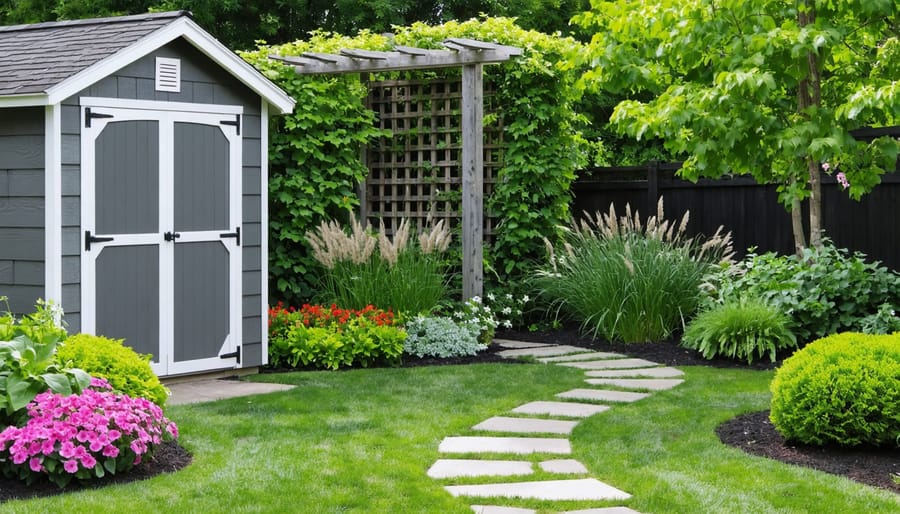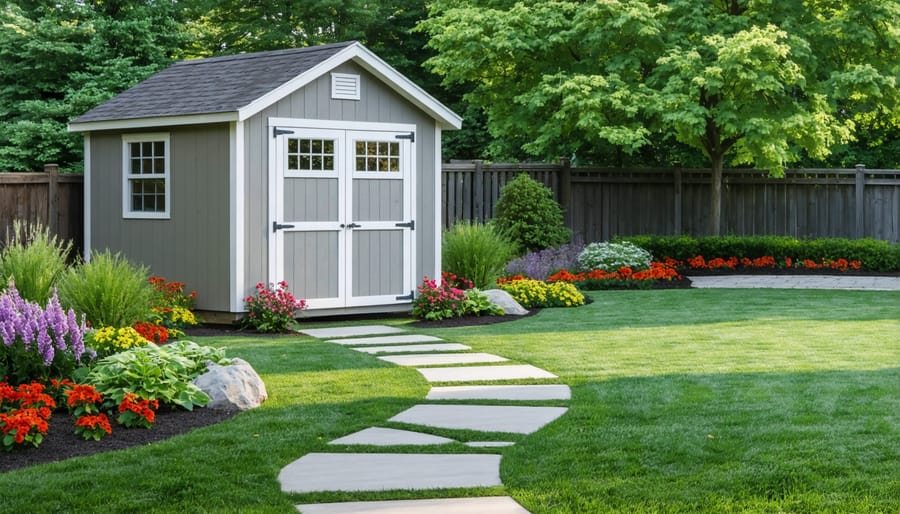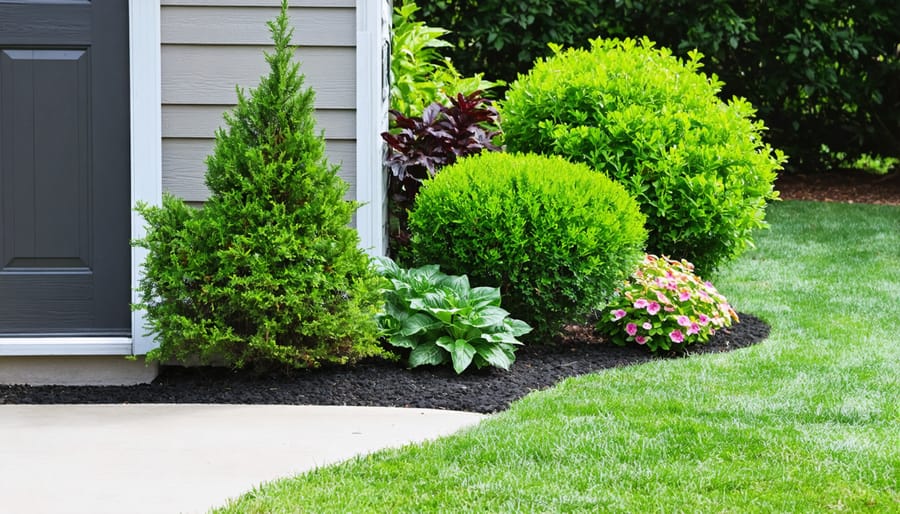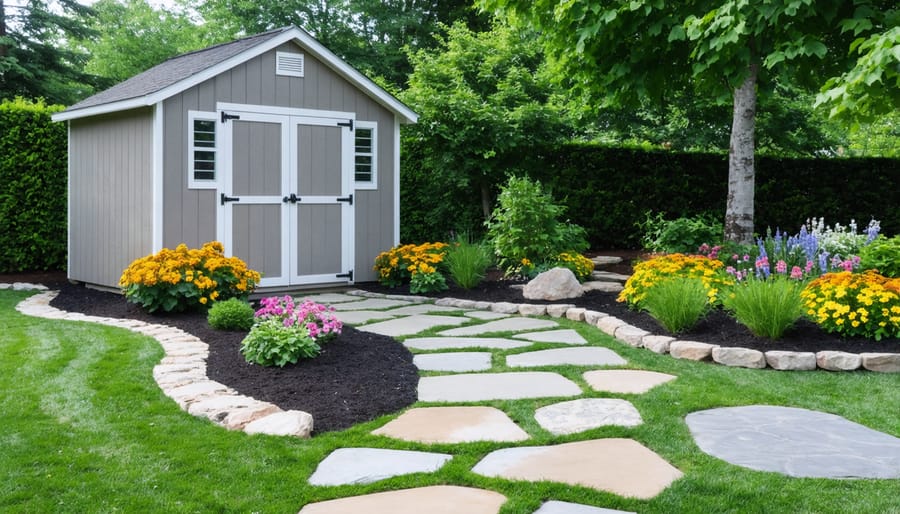Transform Your Storage Shed into a Stunning Landscape Feature

Transform your storage shed into a charming backyard focal point by creating layers of strategic landscaping that blend functionality with visual appeal. Plant tall ornamental grasses and flowering perennials in graduated heights to soften rigid shed lines while maintaining easy access. Install curved pathways using materials that complement your home’s exterior, directing natural foot traffic and creating visual flow between your shed and main landscape features. Incorporate year-round interest with evergreen foundation plantings that anchor the shed to its surroundings, while seasonal bloomers add bursts of color and texture throughout the growing season. Position climbing vines on decorative trellises to add vertical interest and naturally integrate the structure into your garden space, being careful to maintain adequate airflow around the building’s foundation. These thoughtful design elements work together to elevate your shed from a mere storage solution to an intentional, integrated element of your outdoor living space.
Creating a Natural Flow with Strategic Placement
Site Selection Fundamentals
Selecting the perfect spot for your garden storage sheds requires careful consideration of both practical and aesthetic factors. Start by identifying a level area that’s easily accessible from your home, ensuring there’s enough space for door clearance and regular maintenance. The location should have proper drainage to prevent water accumulation around the foundation, which can damage your shed over time.
Consider your yard’s natural traffic patterns and choose a spot that doesn’t obstruct movement or create awkward corners. Sunlight exposure is crucial – while some shade can protect your shed from harsh weather, too much can promote moisture buildup and moss growth. Factor in local building codes and property lines, typically requiring setbacks of 5-10 feet from boundaries.
For visual harmony, try positioning your shed where it complements existing landscape features rather than competing with them. Using your home’s architectural style as a guide, place the shed where it creates a natural flow with other outdoor elements. Remember, the goal is to make your shed look intentional and integrated, not like an afterthought.

Distance and Sight Line Planning
When positioning your shed, consider both practical access and visual impact from key viewing points in your yard. A good rule of thumb is to stand at your most-used outdoor areas, like your patio or deck, and imagine how the shed will look from these vantage points. Try to position the shed where it won’t obstruct important sight lines or create an eyesore from your favorite relaxation spots.
Distance planning is equally crucial. Keep your shed at least 10-15 feet away from your home to maintain a comfortable walking path while preventing it from overwhelming your house visually. For utility sheds, consider positioning them within easy reach of areas where you’ll be using tools and equipment most frequently, such as vegetable gardens or work areas.
Remember to account for shadows cast by your shed throughout the day. This impacts not only the surrounding plants but also how the structure integrates into your landscape. If possible, use the natural contours of your yard to your advantage, positioning the shed where it feels like a natural extension of the landscape rather than an afterthought.
Plant Selection and Arrangement
Foundation Plantings
Foundation plantings serve as the perfect way to anchor your shed into the landscape while softening its architectural lines. When selecting plants for the immediate area around your shed base, choose varieties that won’t interfere with the structure’s foundation or create moisture problems against the walls.
Low-growing evergreen shrubs like boxwood, juniper, or holly make excellent choices for the front corners of your shed. These provide year-round interest and help transition the building into your landscape. For added depth, consider planting them in groups of three or five.
Between these anchor plants, incorporate perennials that match your local climate. Drought-tolerant options like lavender, sedum, or black-eyed susans work particularly well, as they won’t require frequent watering near your shed’s foundation. Keep mature plant sizes in mind – you’ll want varieties that stay under your shed’s windows and don’t block access to doors.
For the closest plantings to your shed base, maintain a 6-12 inch gap between mature plants and the structure to prevent moisture buildup and allow for proper air circulation. Consider adding a layer of gravel or decorative stone in this space to create a clean border and improve drainage.
Remember to factor in the amount of sunlight your shed location receives. North-facing walls will require shade-tolerant plants like hostas or ferns, while south-facing areas can support sun-loving varieties. By choosing the right combination of plants, you’ll create an attractive transition that makes your shed look like it’s always been part of your landscape.

Transitional Greenery
Creating a seamless transition between your shed and the surrounding landscape is essential for a polished, cohesive look. Start with taller plants and shrubs near the corners of your shed to soften its angular lines. Evergreen shrubs like boxwood or holly work wonderfully as anchor plants, providing year-round structure and visual appeal.
Layer your plantings by height, with medium-sized perennials like lavender, sage, or black-eyed susans in the middle ground. These plants not only add color but also create depth and interest throughout the growing season. For the foreground, consider low-growing groundcovers such as creeping thyme or sedum, which help prevent weed growth and add texture to your design.
Climbing plants can transform your shed’s appearance dramatically. Virginia creeper, climbing hydrangea, or jasmine can be trained to grow up trellises or lattice panels, helping the structure blend naturally with its surroundings. Just be sure to install proper supports and maintain regular pruning to prevent damage to your shed’s walls.
Consider incorporating native plants that match your local ecosystem. They’ll require less maintenance, attract beneficial wildlife, and naturally complement your existing landscape. Plant them in groups of odd numbers for a more natural-looking arrangement.
For year-round interest, mix plants with different blooming seasons. Spring bulbs, summer perennials, and autumn-flowering plants ensure continuous color, while ornamental grasses provide movement and winter interest. Remember to leave enough space between plants for growth and maintain proper spacing from your shed’s foundation to prevent moisture issues.
Hardscape Elements
Pathways and Access
Creating accessible and attractive pathways to your shed is essential for both functionality and visual appeal. A well-designed path not only makes it easier to transport garden tools and equipment but also helps integrate your shed seamlessly into your landscape design.
For daily use, consider installing a pathway that’s at least 3 feet wide to accommodate wheelbarrows and garden carts. Materials like gravel, stepping stones, or pavers are popular choices that combine durability with aesthetic appeal. Gravel paths offer excellent drainage and a natural look, while concrete pavers provide a more structured appearance and stable footing in all weather conditions.
Illuminate your pathway with solar-powered lights or low-voltage landscape lighting to ensure safe access during evening hours. Position lights along the edges of the path at regular intervals, focusing on any turns or steps.
To soften the look of your pathway, plant low-growing ground covers between stepping stones or along the edges. Creeping thyme or sedum are excellent choices that can withstand foot traffic and add visual interest. For a more formal appearance, consider lining the path with matching border plants or small shrubs.
Remember to grade the path slightly away from your shed to prevent water from pooling near the foundation. Adding a slight crown to the middle of the path will help direct water to the sides, protecting both your pathway and shed from water damage.
Decorative Features
Adding decorative hardscape elements around your shed creates visual interest and helps blend the structure seamlessly into your landscape. Start with a well-defined border using natural stone or brick pavers to create a clean transition between your shed and the surrounding area. Consider laying a gravel or crushed stone path leading to your shed’s entrance – this not only looks attractive but also provides practical, all-weather access.
Mulch is an excellent addition around your shed’s foundation, helping to prevent weed growth while adding a polished look. Choose natural cedar or pine mulch for its attractive appearance and long-lasting properties. For added character, incorporate large decorative rocks or boulders strategically placed around the shed’s perimeter.
Consider installing window boxes or hanging baskets to add charm and color to your shed’s exterior. These can be complemented by outdoor lighting ideas such as solar-powered path lights or wall-mounted fixtures to create ambiance and improve visibility.
Raised flower beds with stone or timber borders can soften the shed’s appearance while providing additional gardening space. For a rustic touch, consider using reclaimed materials like old wagon wheels, vintage garden tools, or weathered wood as decorative accents. Remember to maintain consistency with your home’s overall landscaping style to create a cohesive look throughout your property.

Maintenance and Seasonal Considerations
Year-Round Care
Maintaining your shed’s landscape requires attention throughout the year to keep it looking its best and functioning properly. In spring, focus on clearing winter debris, pruning any damaged branches, and refreshing mulch around your plantings. This is also the perfect time to organize your shed space and inspect the foundation for any winter damage.
Summer maintenance involves regular watering of plants, especially during dry spells, and trimming back any overgrown vegetation that might contact the shed’s walls. Keep grass trimmed near the foundation and monitor for pest activity around your landscaping.
As autumn approaches, remove fallen leaves regularly to prevent moisture buildup around the foundation. Cut back perennials and add a fresh layer of mulch to protect plant roots during winter. Check gutters and drainage systems to ensure proper water flow away from the shed.
Winter care focuses on snow removal from pathways and monitoring ice buildup on the roof. Brush snow off evergreen branches near the shed to prevent breakage, and regularly check that winter protection measures for delicate plants remain secure.
Quarterly inspections of hardscaping elements like pathways and retaining walls will help identify any needed repairs before they become major issues. Keep a maintenance calendar to track seasonal tasks and ensure nothing gets overlooked in your shed landscape care routine.
Weather Protection
Protecting your shed and its surrounding landscape from weather damage is crucial for long-term durability and aesthetic appeal. Start by installing proper gutters and downspouts to direct rainfall away from your shed’s foundation and nearby plants. Position downspouts to feed into rain gardens or drainage systems that prevent soil erosion and water pooling.
Consider installing a French drain system around your shed if you experience regular heavy rainfall. This hidden drainage solution helps protect both the structure’s foundation and prevents oversaturation of nearby plant roots. Adding gravel or crushed stone around the shed’s perimeter creates an attractive buffer zone that reduces splash-back during storms and helps maintain proper drainage.
For wind protection, strategically place taller shrubs or small trees as windbreaks, but keep them at least 5-6 feet from the shed to prevent root damage and debris accumulation. Choose plants that can withstand local weather conditions and provide year-round protection. Evergreen varieties like juniper or holly make excellent choices.
Don’t forget about snow and ice considerations in colder climates. Install snow guards on sloped shed roofs to prevent dangerous snow slides onto delicate plants below. Keep pathways clear and slightly sloped away from the shed, and use salt-tolerant plants in areas where you might need to apply ice melt in winter months. Regular maintenance of your weather protection features will ensure they continue to safeguard both your shed and landscape effectively.
Transforming your shed area into a beautiful and functional landscape is an achievable goal that can dramatically enhance your property’s appeal and value. By carefully considering factors like proper placement, selecting appropriate plants, incorporating hardscaping elements, and maintaining proper drainage, you can create a seamless integration between your shed and surrounding yard space.
Remember that successful shed landscaping starts with thorough planning. Take time to assess your specific needs, consider your local climate, and evaluate your maintenance capabilities before breaking ground. Whether you choose to create a charming cottage garden around your shed, establish a practical workspace, or develop a multi-functional outdoor area, the key is to balance aesthetics with functionality.
Don’t be afraid to start small and expand your design over time. Begin with essential elements like proper grading and basic plantings, then gradually add features like pathways, lighting, or decorative elements as your budget and time allow. The satisfaction of seeing your shed transform from a simple storage building to a stunning focal point in your yard makes the effort worthwhile.
Consider reaching out to local gardening groups or landscape professionals for additional guidance if needed. With proper planning, the right plant choices, and regular maintenance, your shed landscape project can become a source of pride and enjoyment for years to come. Take that first step today, and watch as your vision for a beautiful shed landscape comes to life.

